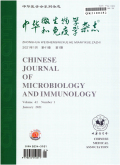2008—2021年广东省柯萨奇病毒B3型的流行及基因特征分析
Epidemiological and genetic characteristics of coxsackievirus B3 in Guangdong Province, 2008-2021
摘要目的:了解2008—2021年柯萨奇病毒B3型(coxsackievirus B3, CVB3)在广东省的流行及基因特征情况。方法:对2008—2021年收集的非肠道病毒71型(enterovirus 71,EV71)/柯萨奇病毒A16型(coxsackievirus A16,CVA16)/CVA6(以下简称其他肠道病毒)阳性的手足口病病例标本、2020—2021年疱疹性咽峡炎病例和新生儿感染病例标本进行肠道病毒检测及分型鉴定,选取CVB3阳性标本分离病毒,对CVB3毒株进行VP1全长序列扩增与测序,运用生物信息学软件DNAStar 7.1和MEGA 6.06分析遗传进化特征。结果:2008—2021年3 484例其他肠道病毒阳性的手足口病病例中,CVB3阳性率为1.6%(57/3 484);2020—2021年560例疱疹性咽峡炎病例中,CVB3阳性率为2.1%(12/560);1例2021年新生儿感染病例CVB3阳性。按年份统计,2021年CVB3阳性病例数最多,占67.1%(47/70),其次为2020年,占18.6%(13/70),其余年份均在5例以下。从CVB3阳性标本中分离得到48株CVB3毒株,共获得26条CVB3毒株VP1基因全长序列。遗传进化分析显示,CVB3可分为A~H等8个基因型,中国大陆存在A、D、E等基因型CVB3毒株的流行。本研究26株广东省CVB3毒株VP1核苷酸相似性为80.2%~100.0%,包括D和E两种基因型,其中D基因型流行于2008—2017年,E基因型流行于2020—2021年。结论:2008—2017年CVB3在广东省呈散发流行,而在2020—2021年流行强度呈上升态势。2008—2021年广东省存在D和E基因型CVB3的流行,其中E基因型是2020—2021年的流行株。
更多相关知识
abstractsObjective:To study the epidemiological and genetic characteristics of coxsackievirus B3 (CVB3) circulating in Guangdong Province from 2008 to 2021.Methods:This study collected the specimens of hand, foot, and mouth disease (HFMD) cases from 2008 to 2021 that were positive for other enteroviruses except for enterovirus 71 (EV71), coxsackievirus A16 (CVA16), and CVA6, as well as the specimens of herpangina and neonatal infection cases from 2020 to 2021. Enteroviruses in these specimens were detected and their types were identified. CVB3 strains were isolated and the entire VP1 sequences of CVB3 strains were amplified and sequenced. The genetic features of CVB3 strains were analyzed using DNAStar 7.1 and MEGA 6.06 software packages.Results:Among 3 484 HFMD cases positive for other enteroviruses from 2008 to 2021, CVB3-positive cases accounted for 1.6% (57/3 484); among 560 cases of herpangina from 2020 to 2021, CVB3-positive cases accounted for 2.1% (12/560); one neonatal infection case in 2021 was positive for CVB3. CVB3-positive cases accounted for 67.1% (47/70) in 2021 and 18.6% (13/70) in 2020, while there were less than five cases in other years. Forty-eight CVB3 strains were isolated and the entire VP1 sequences of 26 CVB3 strains were obtained. Phylogenetic analysis indicated that the CVB3 strains could be divided into eight genotypes (A-H) and the strains of genotypes A, D and E were prevalent in the Chinese mainland. The 26 CVB3 strains isolated in Guangdong Province shared 80.2%-100.0% nucleotide homology, and belonged to two genotypes of D and E, with genotype D prevalent from 2008 to 2017 and genotype E prevalent from 2020 to 2021.Conclusions:CVB3 is prevalent sporadically in Guangdong Province from 2008 to 2017, but the epidemic intensity increased during 2020 and 2021. CVB3 strains of genotypes D and E are prevalent in Guangdong Province during 2008 to 2021, with genotype E being the prevalent genotype during 2020 and 2021.
More相关知识
- 浏览0
- 被引0
- 下载0


相似文献
- 中文期刊
- 外文期刊
- 学位论文
- 会议论文



 换一批
换一批 换一批
换一批



